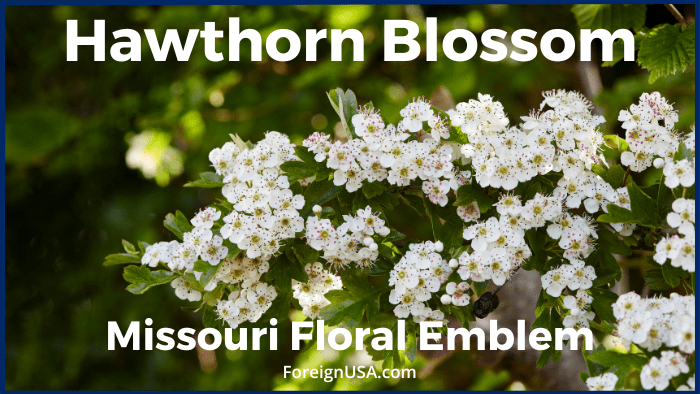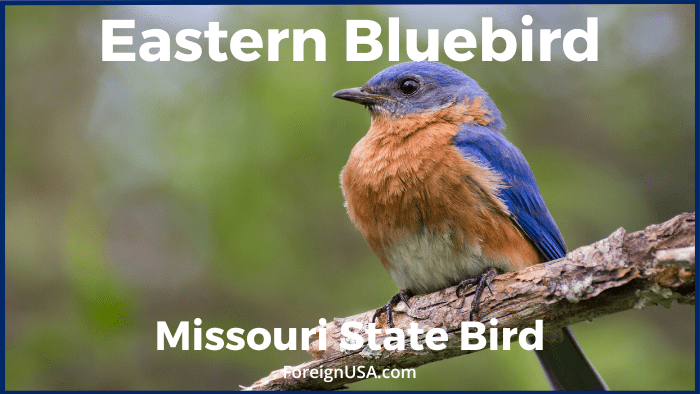Deep in the heart of the United States lies the fascinating Missouri state.
The Show-Me-State is not just a natural wonderland, boasting beautiful landscapes, stunning scenery, and culturally significant cities, it also identifies with a whole host of state symbols, adopted to represent the state’s past and present triumphs.
From the majestic Eastern Bluebird, gliding through the skies, to the delicate and precious state flower, blossoming across the wild planes, accompany us on a journey to explore the captivating world of Missouri state symbols.

Here is the Missouri State Symbols List
Missouri state symbols and emblems have been a staple since the first one was officially adopted in 1822. These symbols are responsible for many interesting facts about the state, both from the past and present.
Below is the official symbols list detailing the most significant state symbols and emblems related to Missouri.
Additionally, we have provided a comprehensive and easy-to-follow table at the bottom of the page showing all 40 Missouri state symbols and emblems for your reference.
Missouri State Seal
It was on January 11, 1822, when the General Assembly adopted an act that provided the official Great Seal of the State of Missouri. The legislation specifically designated the symbols on the state seal and where they would be placed.
The center of the state seal consists of two main parts; the right-hand side is the United States coat of arms, which contains the bald eagle. Arrows and olive branches are being held by the eagle, which signifies the power of war and peace in the U.S.

On the left-hand side, there is a grizzly bear and a silver crescent moon from the official state (Missouri) coat of arms. The crescent is supposed to represent the state at the time of the seal’s creation.
Missouri State Flag
The famous Missouri state flag was designed by Mare Elizabeth Watkins Oliver on March 22, 1913, almost 92 years after Missouri was adopted into the union, becoming the 24th state to do so.
As far as designs go, Missouri’s flag is rather basic – rectangular, consisting of three stripes horizontally, red, white, and blue. The stripes in question represent valor, purity, vigilance, and justice.

A circle features in the middle of the flag, surrounded by a blue band, which features the Missouri Coat of Arms and State Seal. The 24 white stars that you can see feature on this represent Missouri being the 24th state.
Missouri State Floral Emblem
The Missouri state floral emblem, or state flower, is the hawthorn blossom and was made official in 1923 by Gov. Arthur M. Hyde.
Missouri is home to over 75 species of hawthorn plants, one of the key factors in its adoption to represent the state.

Each of the different varieties shares white blossoms, sporting five petals, and are indistinguishable in appearance from apple blossoms.
During fall, the blossom trees sprout clusters of red fruit, which has led to the hawthorn’s nickname, “red haw”.
Missouri State Bird
Missouri’s state bird has been the eastern bluebird since 1927. The state bird of Missouri was adopted as a symbol of happiness. These birds are tiny in size and stature, even smaller than robins.
Their name derives from the males showcasing bright blue feathers on their tail, head, back, and wings.

Typically, you will see them inhabit Missouri between the early spring and the late fall, with certain areas in the south of the state having them all year.
They also breed in both the spring and summer months and have become incredibly popular amongst Missouri locals, with many adding bluebird houses to their gardens to attract them.
Not only is their red, white, and blue coloration a symbol of the United States but also of the Missouri state flag’s colors.
Missouri State Mineral
1967 saw Missouri add a new state symbol, this time in the form of a state mineral. The state mineral of Missouri is galena, a blue/grey and sometimes black mineral sporting an almost metallic appearance made up of lead sulfide and is the main ore in lead.
Galena mining played a significant role in growing the state’s economy, with southwest Missouri being a hotbed, and is now a part of the Tri-State Mining District.

Lead mining was important to early European settlers in Missouri and still is today. Missouri’s Doe Run Mines and Buick Mine make up the second-largest lead mining district on the planet!
Missouri State Insect
Many states, such as Arkansas, Georgia, and Kansas have adopted the honeybee as their state insect, and, you guessed it – Missouri is no different!
The official adoption occurred in 1985 after Gov. John Ashcroft signed a bill appointing the Western Honeybee (Apis mellifera) as the state’s new insect symbol.
Western honeybees are particularly identifiable due to their darker yellow/orange and black stripes covering their bodies, accompanied by their particularly furry heads.

Funnily enough, these honeybees are not native to Missouri, or the United States for that matter, originating from Africa.
Their names are self-explanatory – they make honey out of nectar collected via their role in pollinating flowers.
Bees are tremendously important to not only Missouri’s ecosystem but the ecosystem of the entire world!
Missouri State Animal
The official state animal of Missouri has been the Missouri mule ever since being adopted by Gov. Mel Carnahan in 1995. Mules are fascinating animals as they are a hybrid of both female horses and male donkeys!
Mules were first introduced to the state during the 19th century, where they played a pivotal role in pulling wagons across fields for agricultural purposes and also moving troops and supplies during both WWI and WWII.

Their incredibly hardy nature made them extremely favorable for work no matter what season, displaying reliability that was hard to come by.
Missouri State Aquatic Animal
1997 was the year Missouri officially adopted an aquatic animal as a state symbol; the animal in question is the paddlefish. Despite being home to a plentiful number of rivers, there are only three within the state that can support large populations of paddlefish.
This isn’t to say that they don’t reside in the other water systems within Missouri, such as some of the larger lakes. Instead of having bones, they have a primitive cartilage skeleton, making them pretty unique compared to most other fish.

Typically, paddlefish are 5 feet or longer in length and weigh around 60 lbs (pounds). In some circumstances, if left in their natural habitat, with some good luck, they can live for over 30 years!
Missouri State Fish
During the same year the Missouri state aquatic animal was adopted, the Missouri state fish was adopted too. This occurred shortly after Gov. Mel Carnahan signed a bill to assign the channel catfish (Ictalurus punctatus) as the official state fish.
These catfish, much like many others, rely on their whiskers to probe for their meals; these are called barbles. Their bodies are thinner than other subspecies, and they sport a forked tail.

Younger catfish have spots that tend to disappear once they reach full maturity and size. They are also omnivores, consuming a mixed diet of both plant and meat-based foods.
The adults will usually grow anywhere between 12 and 32 inches long and can weigh between 1 to 15 lbs (pounds) – these factors rely heavily on their environment.
Missouri State Amphibian
The Missouri state amphibian is one of the more recent adoptions, with the American bullfrog designated in 2005. These frogs are native to the state and can be found in every county within Missouri.
They are the largest and certainly most aggressive frog to reside in the state. You can easily identify the males through their deep “jug-oh-rum” call/ribbit on warm, humid, and often rainy nights during the months of May, June, and July.

Between July and October, you can legally hunt these amphibians, and if you are a resident of Missouri who is 16 years old or younger or 65 and older, you can hunt these frogs without a permit.
Missouri State Reptile
In 2007, Missouri adopted the three-toed box turtle as the official state reptile. These land-occupying turtles are incredibly unique in appearance and behavior, not to mention they are found all across the Show-Me State.
Their name certainly gives away an aspect of their appearance, their toes! They typically only have three hind toes; however, there have been some exemptions.

Also, their hinged shell, similar to most other turtles, is used as a home to retreat inside if necessary. The males have red eyes, and the females are brown. You can find these unique little reptiles all across the state.
Also important to note is that box turtles cannot survive for very long without water, but Missouri, at least not until recently, does not usually suffer from drought conditions, so they typically thrive in this environment.
Missouri State Symbols Table
Now that we have covered some of the most notable Missouri state symbols and emblems let’s take a look at all of them!
Below is a table of all 40 symbols and emblems associated with Missouri state and its past and present achievements, including the date on which they were enacted:
| Type of Symbol | State Symbol | Year |
|---|---|---|
| American folk dance | Square dance | 1995 |
| Amphibian | North American bullfrog (Rana catesbeiana) | 2005 |
| Animal | Missouri mule | 1995 |
| Aquatic animal | Paddlefish or Spoonbill (Polyodon spathula) | 1997 |
| Arboreal emblem | Flowering dogwood (Cornus Florida L.) | 1955 |
| Bird | Bluebird (Sialia sialis) | 1927 |
| Day | Missouri Day, 3rd Wednesday in October | 1915 |
| Dessert | Ice cream cone | 2008 |
| Dinosaur | Hypsibema missouriensis | 2004 |
| Exercise | Jumping jacks | 2014 |
| Fish | Channel catfish (Ictalurus punctatus) | 1997 |
| Flag | Great State Flag of Missouri | 1913 |
| Floral emblem | Hawthorn blossom (Crataegus) | 1923 |
| Fossil | Fossilized remains of Crinoidea (Delocrinus missouriensis) | 1989 |
| Game bird | Bobwhite quail (Colinus virginianus) | 2007 |
| Grape | Norton/Cynthiana grape (Vitis aestivalis) | 2003 |
| Grass | Big bluestem (Andropogon gerardii) | 2007 |
| Great seal | Great State Seal of Missouri | 1822 |
| Horse | Missouri fox trotting horse | 2002 |
| Insect | Honeybee (Apis mellifera) | 1985 |
| Invertebrate | Crayfish, also called crawfish and crawdad | 2007 |
| Lithologic emblem | Mozarkite | 1967 |
| Mineral | Galena | 1967 |
| Musical instrument | Fiddle | 1987 |
| Reptile | Three-toed box turtle (Terrapene carolina triunguis) | 2007 |
| Song | "Missouri Waltz" | 1949 |
| Tree nut | Nut of the Eastern black walnut tree (Juglans nigra) | 1990 |
| Child Abuse Symbol | Blue Ribbon | 2011 |
| Endangered Species | Hellbender Salamander | 2019 |
| Fruit Tree | Pawpaw | 2019 |
| Gold star memorial monuments | List of gold star memorial monuments here | 2020 |
| Historical dog | Old Drum | 2017 |
| Hockey team | St Louis Blues | 2019 |
| Korean War Vet Memorial | War Veterans Memorial in Kansas City | 2020 |
| Monument | The Gateway Arch | 2021 |
| Purple Martin Capital | Purple Martins | 2003 |
| Rifle | Hawken Rifle | 2023 |
| Tartan | Show Me Tartan | 2019 |
| Wonder Dog | Jim the Wonder Dog | 2017 |
| UFO Capitals of Missouri | Piedmont and Wayne County | 2023 |


